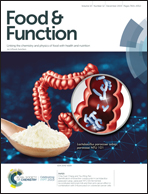Anti-fatigue effect of anwulignan via the NRF2 and PGC-1α signaling pathway in mice
Abstract
Objective: To examine the anti-fatigue function of anwulignan from Schisandra and its underlying mechanism. Methods: After an excessive fatigue mouse model was created, anwulignan was administered to the mice, and its effect on exercise tolerance was studied by the weight-bearing swimming test, rotarod test, grip strength test, and tail suspension test. The biochemical indicators closely related to fatigue, including blood urea nitrogen (BUN), lactic acid (LD), lactate dehydrogenase (LDH), and creatine kinase (CK) in the serum; liver glycogen (LG) in the liver tissue; muscle glycogen (MG); inorganic phosphate (Pi) and Annexin V in the gastrocnemius; superoxide dismutase (SOD) and glutathione peroxidase (GSH-Px) activities; malondialdehyde (MDA), catalase (CAT), and thiobarbituric acid reactive substances (TBARS); and the 8-hydroxy-2-deoxyguanosine (8-OHdG) and reactive oxygen species (ROS) content in both serum and the gastrocnemius were detected. Morphological changes were also observed. The anti-fatigue-related proteins of the NRF2/ARE, Bcl2, and PGC-1α pathways in the gastrocnemius of the mice were detected by western blot. Results: Anwulignan significantly increased the exercise tolerance by decreasing BUN, LD, LDH, CK, Pi, MDA, TBARS, 8-OHdG, ROS, and Annexin V levels and increasing LG, MG, SOD, CAT, and GSH-Px levels, significantly upregulated the expression of NRF2 and Bcl2 proteins, which are anti-oxidation and anti-apoptosis regulators, and also activated the p38MAPK-PGC-1α pathway. Conclusion: Anwulignan can increase exercise tolerance and relieve fatigue in an excessive fatigue mouse model. The underlying mechanism may be through its regulatory effect on the NRF2 and PGC-1α signaling pathway. This study will provide scientific data for anwulignan to be developed as a novel and efficient component in anti-oxidant or anti-fatigue health food.



 Please wait while we load your content...
Please wait while we load your content...